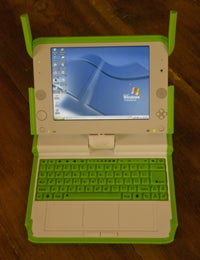It seems as if no matter what Microsoft does to try to kill off Windows XP, the aging operating system seems to endear itself to users.
The One Laptop Per Child (OLPC) initiative and Microsoft announced Thursday that the project to provide extremely inexpensive, though rugged, laptops to children in emerging economies will include a proprietary component — Windows XP.
“The intention is to create a version of the XO laptop that provides the ability to host both Windows and Linux operating systems, giving users the ability to run either on the XO laptop,” a joint statement from the two organizations said.
That causes at least some OLPC supporters outrage, given that the original plans for the OLPC laptops called for the systems to only run open source software – which, of course, XP is not.
However after running preliminary tests over the past several months, the software giant and the philanthropic organization (laptop.org) announced XP will be available on OLPCs.
“Today Microsoft and the OLPC are announcing support for Windows on the OLPC XO computer. The two organizations will work together on several pilot programs in emerging market countries starting next month, and the offering will RTM [be released to manufacturing or RTM] in August or September,” said a blog posting Thursday by James Utzschneider, general manager of marketing and communications for Microsoft’s Unlimited Potential group.
The Unlimited Potential group was formed to work on educational and economical issues in the developing world.
 |
The OLPC laptop Source: Microsoft |
OLPC was founded by Nicholas Negroponte, former head of MIT’s Media Lab, with the goal of producing a laptop for use by the poorest children in emerging nations.
Night of the Living Dead?
The announcement comes at a time when Microsoft has been trying to kill off the seven-year-old XP, but its continued popularity seems to have given it the longevity of Dorian Gray.
Microsoft announced last year that most system builders and OEMs would have to quit selling systems with XP after June 30, 2008. That, however, was an extension from January 30, 2008 when availability was originally supposed to end, and rumors continue to fly that customer demand may force Microsoft to extend the cutoff once again, beyond the end of June.
Just last month, Microsoft announced XP would become the operating system for what it describes as ultra low-cost PCs or ULCPCs, thus extending XPs life for another two years.
“Windows XP Home for ULCPCs will be available until the later of June 30, 2010, or one year after general availability of the next version of Windows [AKA Windows 7],” a company statement said at the time. Nothing has been said about how long XP will be available on the OLPC.
Page 2 of 2
Neither Microsoft nor OLPC talked money in their announcement. However, an FAQ on OLPC’s wiki states that the version of XP planned for use will cost $3 per copy, plus the cost of a 2 GB SD-card to hold the operating system – increasing the cost per laptop by about $10 extra over one with a free copy of Linux.
OLPC will work with third-party developers to port the computer’s standard Sugar user interface for kids over to run on XP, the two organizations’ joint announcement said.
Additionally, according to OLPC, under the terms of the deal, users will still be able to get the units with Linux rather than Windows.
No Free Lunches or Laptops
The move is not without its share of controversies.
Many supporters of OLPC as well as open source advocates are incensed over the announcement, despite its founder’s disclaimers. It is an outrage, they claim, that a laptop that’s entire genesis was premised on the use of free software should suddenly have a proprietary operating system foisted on users, even if Linux comes on the laptops as well.
“From the beginning, the goal of OLPC has been to use technology to transform education by bringing connectivity and constructionist learning to the poorest children throughout the world,” Negroponte, founder and chairman of OLPC, said in online statements. “OLPC remains fully committed to our goal: a completely free and open learning platform for the world’s children.”
In addition, senior Microsoft executives downplayed any profit motives, especially in relation to the OLPC project.
“By supporting a wide variety of affordable computing solutions for education that includes OLPC’s XO laptop, we aim to make technology more relevant, accessible and affordable for students everywhere,” Craig Mundie, Microsoft’s chief research and strategy officer, said in a statment.
That’s not the way Microsoft’s critics see it, though.
“I wonder if Negroponte has done [due diligence] with regard to XP. Is it going to be improved and extended or even maintained?” a blog post on open source advocacy site Groklaw.net said.
The blog continued: “Who will fix it when it crashes? Who will protect the little children from malware, which Microsoft software is so prone to be a victim of? Sugar and the XO was set up to provide real security. Can anyone say the same about Microsoft’s software? What are you doing to those children?”


